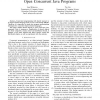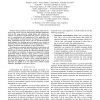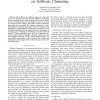WCRE
2010
IEEE
14 years 23 days ago
2010
IEEE
—Bug fixing accounts for a large amount of the software maintenance resources. Generally, bugs are reported, fixed, verified and closed. However, in some cases bugs have to be...
WCRE
2010
IEEE
14 years 23 days ago
2010
IEEE
—We present a semi-automated approach for the reverse engineering of UML sequence diagrams. Our approach starts with a set of execution traces that are automatically aligned in o...
WCRE
2010
IEEE
14 years 23 days ago
2010
IEEE
—In a software project, outsourcing the development of a particular functionality, reusing a part in another software, or handing-over a part of the code to a new team member req...
WCRE
2010
IEEE
14 years 23 days ago
2010
IEEE
—Often stakeholders, such as developers, managers, or buyers, want to find out what software development processes are being followed within a software project. Their reasons in...
WCRE
2010
IEEE
14 years 23 days ago
2010
IEEE
— The paper presents an approach that combines conceptual and evolutionary techniques to support change impact analysis in source code. Information Retrieval (IR) is used to deri...
WCRE
2010
IEEE
14 years 23 days ago
2010
IEEE
Existing software product variants, developed by ad hoc reuse such as copy-paste-modify, are often a starting point for building Software Product Line (SPL). Understanding of how ...
WCRE
2010
IEEE
14 years 23 days ago
2010
IEEE
—Concurrent programming with shared memory in an object-oriented language such as Java is notoriously difficult. Therefore, it is important to study new program understanding te...
WCRE
2010
IEEE
14 years 23 days ago
2010
IEEE
—An important application of binary-level reverse engineering is in reconstructing the internal logic of computer malware. Most malware code is distributed in encrypted (or “pa...
WCRE
2010
IEEE
14 years 23 days ago
2010
IEEE
Abstract—During software development, design rules and contracts in the source code are often encoded through regularities, such as API usage protocols, coding idioms and naming ...
WCRE
2010
IEEE
14 years 23 days ago
2010
IEEE
—The evolution of a software project is a rich data source for analyzing and improving the software development process. Recently, several research groups have tried to cluster s...



